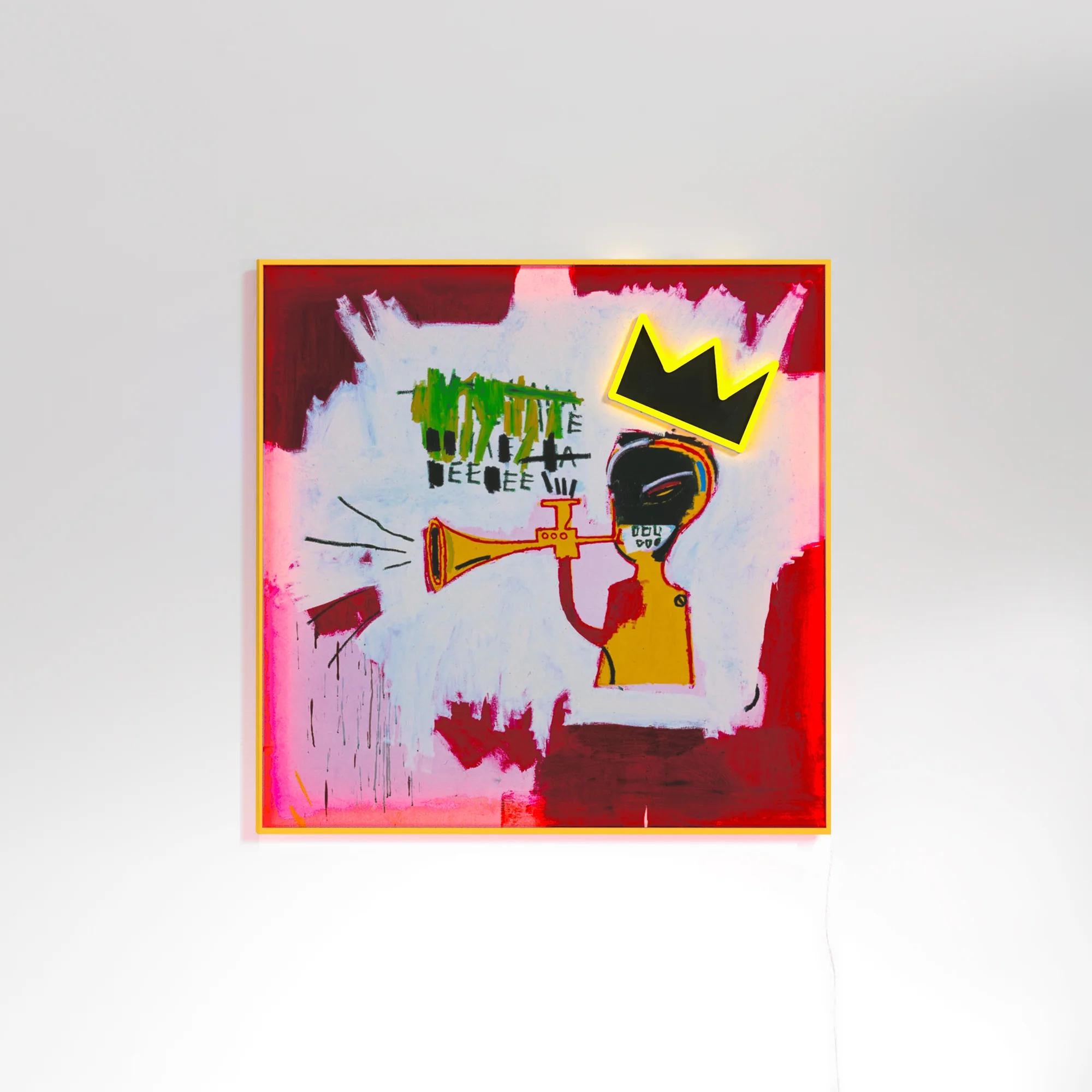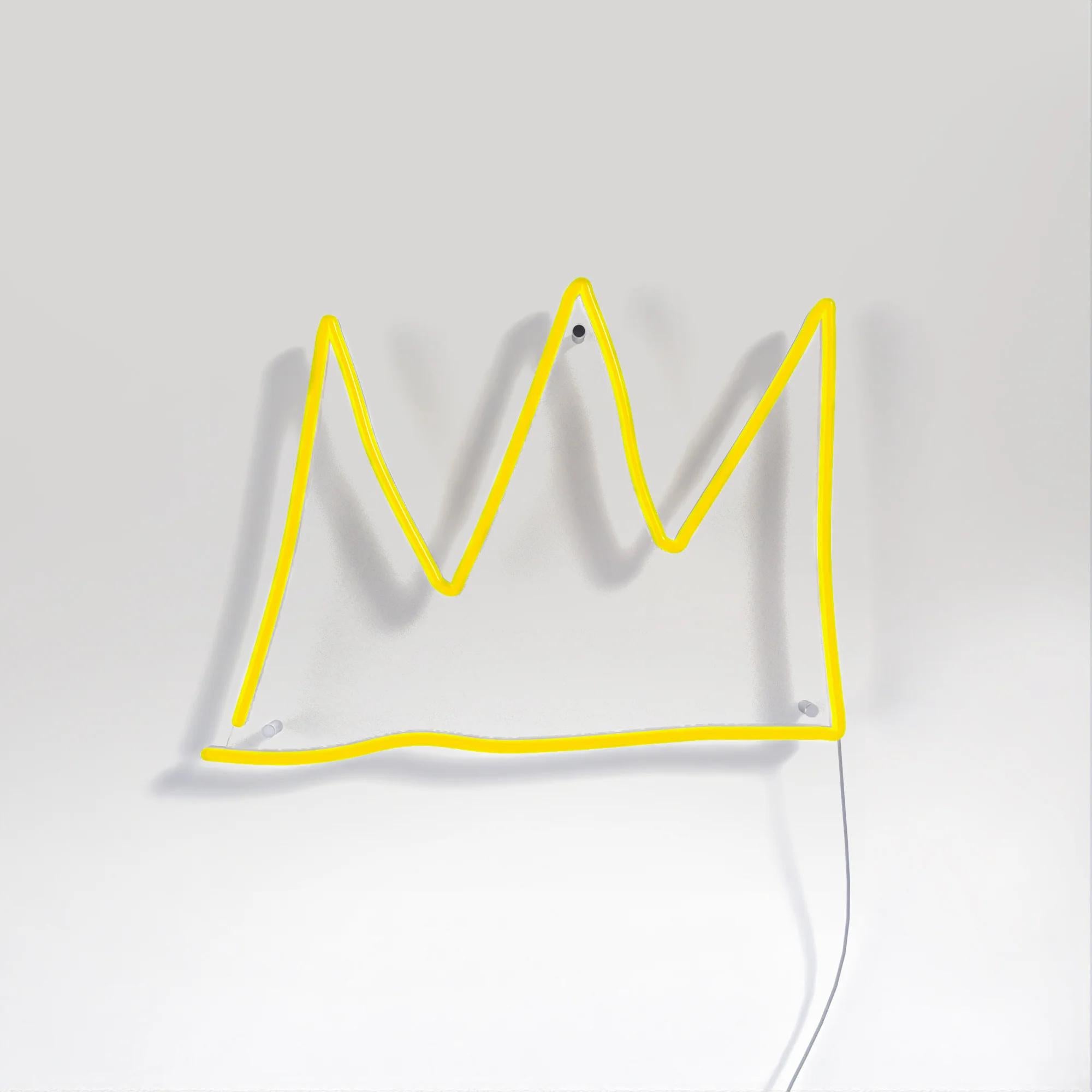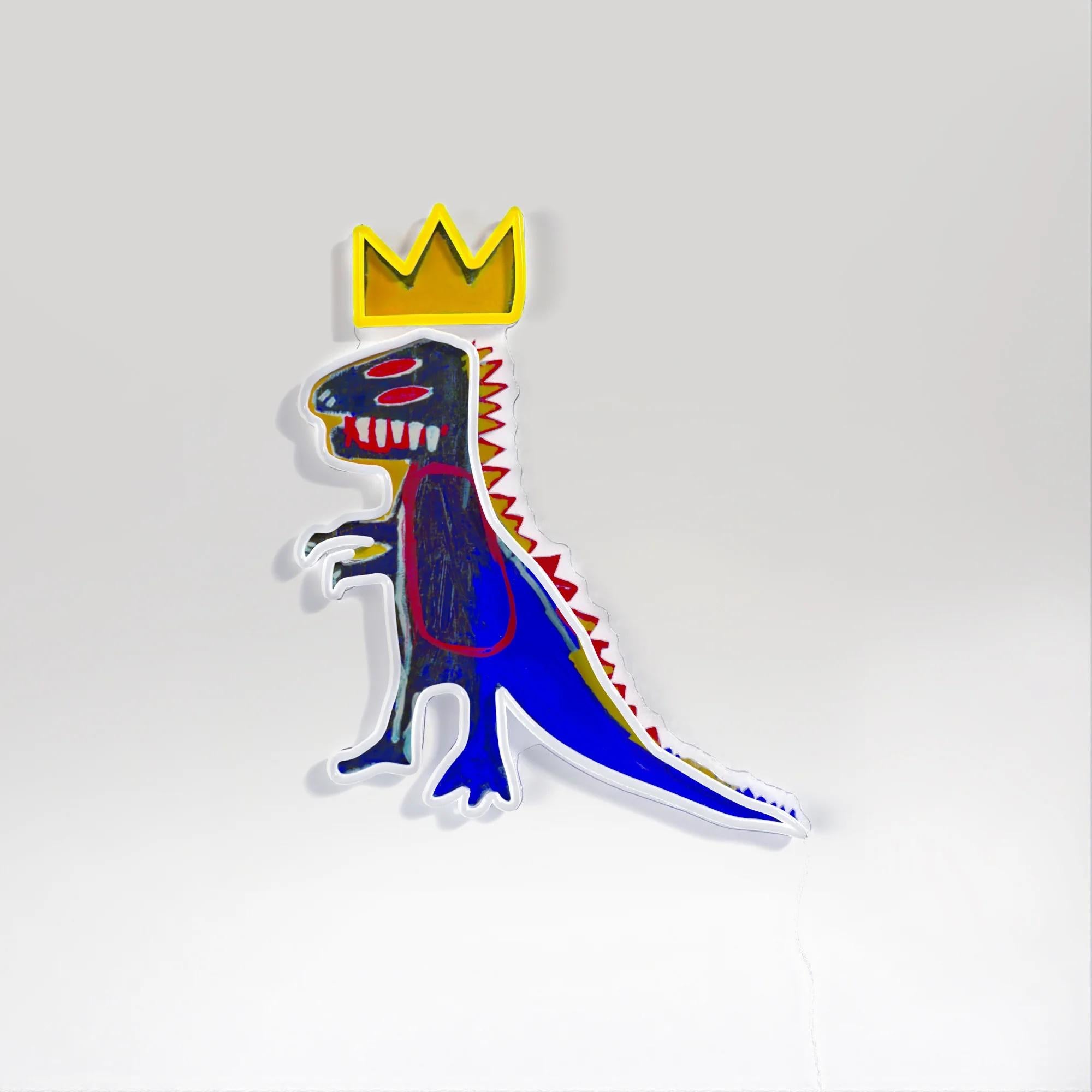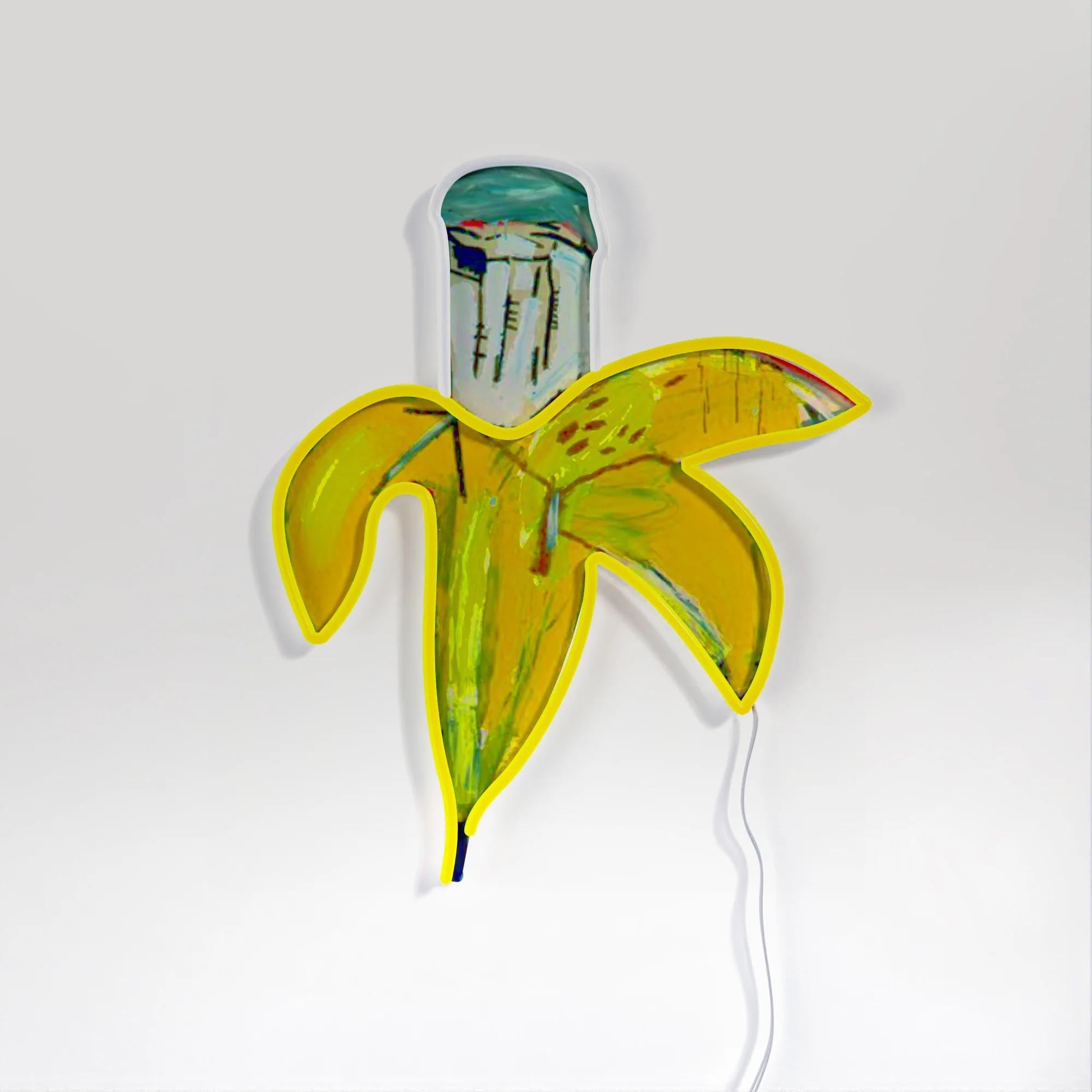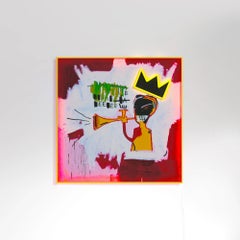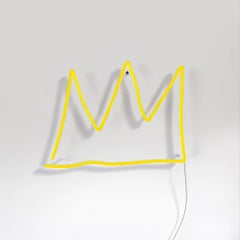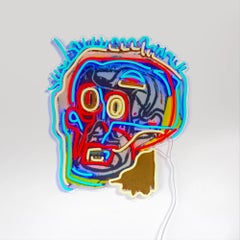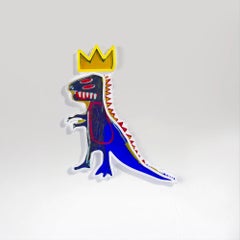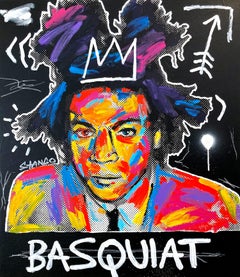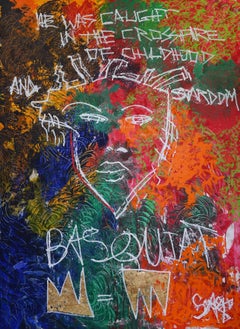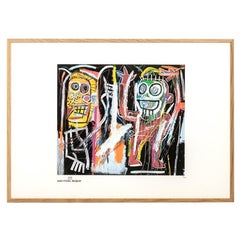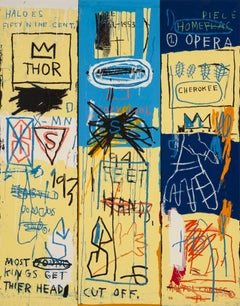Items Similar to Jean-Michel BASQUIAT - Equals Pi YP x JM Basquiat Design Neon LED Lamp. Pop Art
Want more images or videos?
Request additional images or videos from the seller
1 of 7
Jean-Michel BASQUIAT - Equals Pi YP x JM Basquiat Design Neon LED Lamp. Pop Art2024
2024
$704.17
£535.44
€595
CA$988.03
A$1,079.63
CHF 559.72
MX$12,897.70
NOK 7,122.72
SEK 6,668.55
DKK 4,531.85
About the Item
Equals Pi YP x JM Basquiat
Date of creation: 2024
Medium: PVC or Silicon piping with LED lights mounted on recycled acrylic board
Edition: Open
Size: 52 x 52 cm
Condition: Brand new
Jean-Michel Basquiat's Equals Pi (1983) is an intriguing work that reflects the artist's unique approach to language, mathematics, and social criticism. The title of the work, Equals Pi, refers to a mathematical equation involving the equals symbol and the number Pi (π), an irrational and transcendental number that has profound significance in both mathematics and art. Basquiat, known for his interest in symbols, codes and the blending of disciplines, uses these elements to explore themes of knowledge, power and the perception of reality.
The work features a central human figure, as is typical in many of Basquiat's paintings, which is surrounded by graphic elements and symbols that could be related to art and science. The presence of the word "Pi", written prominently, and the mathematical symbol of the equal, generate a visual play between the abstract and the logical, combining scientific language with the artist's visceral expressiveness. By incorporating mathematics into his work, Basquiat also reflects his fascination with complex ideas and how academic knowledge can interact with popular culture, history and politics.
The style of Equals Pi remains characteristic of Basquiat: a free use of painting and drawing, with aggressive strokes and bright colors, creating an atmosphere of controlled chaos. The work can be interpreted as a reflection on how logical and rational structures, represented by mathematics, coexist with the disorder and emotion of the human world. As in other pieces of his career, Basquiat uses Equals Pi to challenge conventions and break down the barriers between different forms of knowledge and communication, inviting the viewer to question how we interpret reality and the disciplines that define it.
This isn't just decor; it's a slice of art history in neon, inviting you to ponder the true value of wisdom and the irony of the dunce cap in a world hungry for enlightenment.
The flexible LED tube is safe and environmentally friendly, too! Set the light to the time of day with adjustable brightness.
© Estate of Jean-Michel Basquiat. Licensed by Artestar, New York.
Each sign is made of a neon flex material, consisting of PVC or Silicon piping with LED lights, that is mounted on a recycled acrylic board. These materials allow to create realistic neon signs, with bright lights and intense color, while being more durable, affordable, and sustainable than traditional neon.
Sustainability is taken seriously thanks to its LED lights which consumes 6 times less energy than traditional lights, lasting up to 100,000 hours. These neon is crafted using recycled materials and 100% recycled packaging, including removing all useless plastic.
- Creation Year:2024
- Dimensions:Height: 20.48 in (52 cm)Width: 20.48 in (52 cm)Depth: 1.58 in (4 cm)
- Medium:
- Movement & Style:
- After:Jean-Michel Basquiat (1960 - 1988, American)
- Period:
- Condition:
- Gallery Location:Madrid, ES
- Reference Number:1stDibs: LU1033117130982
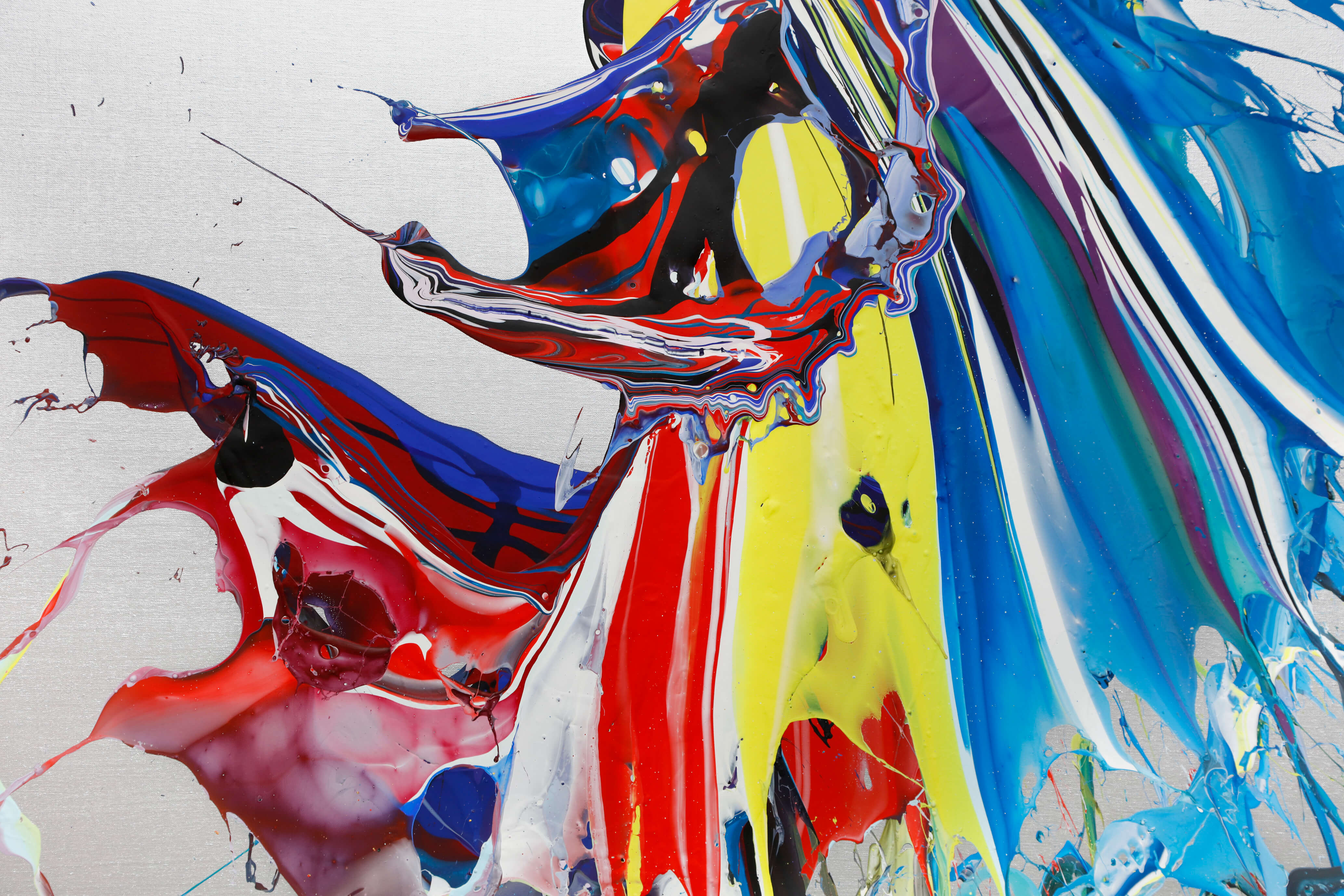
About the Seller
5.0
Vetted Professional Seller
Every seller passes strict standards for authenticity and reliability
Established in 2011
1stDibs seller since 2018
183 sales on 1stDibs
Typical response time: 10 hours
- ShippingRetrieving quote...Shipping from: Madrid, Spain
- Return Policy
More From This Seller
View AllJean-Michel BASQUIAT - Trumpet Painting YP x JM Basquiat Design Neon LED Lamp
By Jean-Michel Basquiat
Located in Madrid, Madrid
Trumpet Painting YP x JM Basquiat
Date of creation: 2024
Medium: PVC or Silicon piping with LED lights mounted on recycled acrylic board
Edition: Open
Size: 52 x 52 cm
Condition: Br...
Category
2010s Pop Art More Art
Materials
LED Light, Neon Light
Jean-Michel BASQUIAT - The Crown YP x JM Basquiat Design Neon LED Lamp
By Jean-Michel Basquiat
Located in Madrid, Madrid
The Crown YP x JM Basquiat
Date of creation: 2024
Medium: PVC or Silicon piping with LED lights mounted on recycled acrylic board
Edition: Open
Size: 40 x 30 cm
Condition: Brand new...
Category
2010s Pop Art More Art
Materials
LED Light, Neon Light
Jean-Michel BASQUIAT - Untitled (Head) YP x JM Basquiat Design Neon LED Lamp
By Jean-Michel Basquiat
Located in Madrid, Madrid
Untitled (Head) YP x JM Basquiat
Date of creation: 2024
Medium: PVC or Silicon piping with LED lights mounted on recycled acrylic board
Edition: Open
Size: 50 x 58 cm
Condition: Bra...
Category
2010s Pop Art More Art
Materials
LED Light, Neon Light
Jean-Michel BASQUIAT - PEZ Dispenser YP x JM Basquiat Design Neon LED Lamp
By Jean-Michel Basquiat
Located in Madrid, Madrid
PEZ Dispenser YP x JM Basquiat
Date of creation: 2024
Medium: PVC or Silicon piping with LED lights mounted on recycled acrylic board
Edition: Open
Size: 40 x 50 cm
Condition: Brand...
Category
2010s Pop Art More Art
Materials
LED Light, Neon Light
Jean-Michel BASQUIAT - Banana YP x JM Basquiat Design Neon LED Lamp
By Jean-Michel Basquiat
Located in Madrid, Madrid
Banana YP x JM Basquiat
Date of creation: 2025
Medium: PVC or Silicon piping with LED lights mounted on recycled acrylic board
Edition: Open
Size: 41 x 50 cm
Condition: Brand new
Jean-Michel Basquiat’s banana is a recurring motif in his work that, like many of his symbols, blends humor, irony, and social critique. At first glance, it may seem trivial or even comical, but within Basquiat’s visual language it takes on multiple layers of meaning.
On one hand, the banana works as a pop reference: an everyday object loaded with cultural, sexual, and even absurd connotations, echoing the tradition of pop art and artists like Andy Warhol (who, in 1967, famously turned the banana into an icon with the album cover for The Velvet Underground & Nico). Basquiat, who both admired and collaborated with Warhol, reintroduces the motif in a playful way, but with a more chaotic and visceral energy.
On the other hand, the banana can be read as a critical symbol: it connects to themes of consumerism, exoticization, and racial stereotypes. The tropical fruit evokes colonial imaginaries and the economic exploitation tied to the trade of “exotic” goods in the West. By incorporating it into his work, Basquiat decontextualizes it and turns it into an emblem full of tensions—between comedy and discomfort, pop lightness and historical memory.
Moreover, the way he depicts it —with energetic, almost childlike strokes, scattered words, and graphic marks— enhances the sense of immediacy and freshness, yet behind this apparent spontaneity lies a sharp reflection on identity, power, and contemporary visual culture.
Ultimately, Basquiat’s banana is not just a fruit: it is a visual artifact that fuses humor, irreverence, and social critique, perfectly embodying the artist’s ability to transform the everyday into a biting commentary on the modern world.
The flexible LED tube is safe and environmentally friendly, too! Set the light to the time of day with adjustable brightness.
© Estate of Jean-Michel Basquiat. Licensed by Artestar, New York.
Each sign is made of a neon flex material, consisting of PVC or Silicon piping with LED lights, that is mounted on a recycled acrylic board. These materials allow to create realistic neon signs, with bright lights and intense color, while being more durable, affordable, and sustainable than traditional neon.
Sustainability is taken seriously thanks to its LED lights which consumes 6 times less energy than traditional lights, lasting up to 100,000 hours. These neon is crafted using recycled materials and 100% recycled packaging, including removing all useless plastic.
ABOUT THE ARTIST
Jean-Michel Basquiat (1960-1988) was one of the most influential artists of the 20th century, famous for his ability to fuse urban culture, social criticism and art history into a unique style. Born in Brooklyn, New York, to a Haitian father and Puerto Rican mother, his life and work were shaped by his multicultural heritage, the New York art scene and the social tensions of his time. Although his career was brief, his impact on contemporary art has been lasting and significant.
Basquiat showed an interest in art from an early age. His mother, Matilde Andrades, took him to museums and encouraged him to draw. At the age of seven, a car accident left him hospitalized for a time, and it was then that his mother gave him a copy of the anatomy book Gray's Anatomy, which influenced his fascination with the human body and its visual representation.
Despite his early talent, Basquiat's family life was turbulent. His mother was hospitalized for psychiatric problems and his relationship with his father, Gerard Basquiat, was troubled. This instability contributed to Basquiat dropping out of school at age 17 to pursue his artistic career on the streets of New York.
As a teenager, Basquiat joined the New York graffiti scene under the pseudonym SAMO (an acronym for "Same Old Shit"), which he used to sign his cryptic and poetic messages on the streets of Manhattan with his friend Al Diaz. SAMO's graffiti were a mixture of philosophical and social commentary on popular culture, capitalism and religion, and soon attracted the attention of the underground art scene.
In 1980, SAMO "died" when Basquiat and Diaz decided to end their collaboration, marking the beginning of Basquiat's transition from street graffiti to art galleries.
Basquiat emerged as a talent to watch in 1980, when he participated in the group exhibition The Times Square Show, which included other emerging artists from New York's Lower East Side scene. That same year, he attracted the attention of critics and collectors who saw in his work an electrifying blend of street art and neo-expressionism, the predominant movement of the time.
In 1981, art critic René Ricard published the influential essay The Radiant Child in Artforum magazine, which positioned Basquiat as one of the most promising artists of his generation. Shortly thereafter, he met renowned artist Andy Warhol, with whom he formed a close friendship and significant artistic collaboration. This association was instrumental in catapulting his career into the world of high art.
The collaboration with Warhol was a pivotal point in Basquiat's career. The two artists, although coming from very different worlds, shared a fascination with fame and popular culture. Together, they produced a series of works that combined Warhol's pop art icons with Basquiat's raw, spontaneous style.
However, this collaboration was also a source of controversy. Many critics accused Warhol of "exploiting" Basquiat, while others saw the collaboration as a creative dialogue between two genius minds. Although the criticism was mixed, there is no doubt that the relationship between the two artists helped cement Basquiat's reputation in the art world.
Basquiat's style is a unique amalgam of influences. His work is characterized by the use of dismembered human figures, skeletons and internal organs, evoking the fragility of the body and mortality. Basquiat also used symbols that alluded to African-American and African history, such as crowns, masks and references to historical figures such as Toussaint Louverture.
The use of text is another crucial aspect of his work. Words, phrases and numbers appeared in his paintings, often crossed out or overlapped, creating a sense of controlled chaos. These fragmented words provoked a non-linear reading of his works and conveyed multiple layers of meaning.
His art also reflected his concerns about racial issues, especially the place of people of African descent in Western art history and in society at large. The crowns that Basquiat often drew on his figures were a symbol of power and resistance, a way of proclaiming himself "king" in a world that had historically excluded black artists from the upper echelons of art.
In works such as The Death of Michael Stewart...
Category
2010s Pop Art More Art
Materials
LED Light, Neon Light
KEITH HARING - Love People YP x Keith Haring Design Neon LED Lamp. Pop Art
By (after) Keith Haring
Located in Madrid, Madrid
Love People YP x Keith Haring
Date of creation: 2024
Medium: PVC or Silicon piping with LED lights mounted on recycled acrylic board
Edition: Open
Size: 52 x 52 cm
Condition: Brand ...
Category
2010s Pop Art More Art
Materials
LED Light, Neon Light
You May Also Like
"Jean-Michel Basquiat" Pop Art Mixed Media & Acrylic Painting on Canvas
By John Stango
Located in New York, NY
A pop piece depicting Jean-Michel Basquiat with impasto painting, spray paint and silkscreening. We are drawn to the movement, as the artist is able to engage his viewer with contras...
Category
2010s Contemporary Abstract Paintings
Materials
Canvas, Acrylic, Mixed Media
BASQUIAT : Caught in the Crossfire: Large Neo Expressionist Oil Painting
By Sax Berlin
Located in Brecon, Powys
Basquiat: Caught in the Crossfire is a very heartfelt and personal tribute to Basquiat and a large statement piece and with this painting Sax takes up the mantle and upgrades the con...
Category
2010s Neo-Expressionist Abstract Paintings
Materials
Gold Leaf
Jean-Michel Basquiat. Numbered color silkscreen print. 1990s.
Located in Saint-Ouen, FR
Jean-Michel Basquiat
Color silkscreen print in its light oak frame.
It is numbered 88/100 and bears the dry stamp of the publisher Rupert Jason Smith (who was Andy Warhol’s printer a...
Category
Late 20th Century American Prints
Materials
Paper
Charles the First
By Jean-Michel Basquiat
Located in New York, NY
From the initial portfolio created posthumously in 2004, Charles the First was created as a screenprint from the painting of the same title. Hand-signed by the artist’s father and w...
Category
21st Century and Contemporary Street Art Prints and Multiples
Materials
Screen
Jean-Michel Basquiat Spray Paint Can 2017
By Jean-Michel Basquiat
Located in NEW YORK, NY
Limited edition Jean-Michel Basquiat Spray Paint Can 2017:
Highly collectible limited edition Jean-Michel Basquiat spray paint can by published ci...
Category
2010s Pop Art More Art
Materials
Metal
'Basquiat' Abstract Street Art Mixed Media Painting, 2024
By Andrew Cotton
Located in New York, NY
Originally from North London, Cotton received his art education at the prestigious Central St. Martins School of Art in Holborn, London. Being a teenager in North London during the g...
Category
2010s Abstract Abstract Paintings
Materials
Mixed Media
